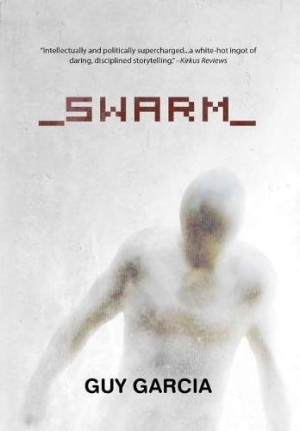Swarm
Swarm rips its plot from today’s headlines and sets up an incredibly introspective and action-packed thriller.
Swarm by Guy Garcia is a rip-roaring techno-thriller tinged with ponderous questions, larger-than-life characters, and an explosive plot.
Three seemingly random people—an American soldier in Afghanistan, a Texas-based hacktivist, and a biologist studying locusts in Africa—find themselves bound by one common thread: the potential for technology-based human evolution.
Tom Ayana, aka Swarm, effortlessly controls flash mobs, drawing the attention of a hacking collective. Given a leaked experimental code, Tom begins to blend mind-control technology with electronic dance music, or EDM, producing small pockets of hive behavior in humans.
Meanwhile, Professor Cara Park delves deeper into the mystery of how and why grasshoppers suddenly transform into devastating locust swarms. As Tom attempts to kick-start human evolution, Cara is driven to prevent a potential global disaster. With federal agents on his trail and a mounting body count, Tom begins to amass power, and attempts to shatter the status quo.
Swarm is an incredibly introspective and action-packed thriller that rips its plot from today’s headlines. Tom/Swarm’s drive to spur evolution seems like a pipe dream until the code to basically meld a group’s mind together drops in his lap.
Tom’s own slow evolution into Swarm is mirrored beautifully in the escalating control over the power to ensnare a large collective of humans into one cohesive unit. All of this is demonstrated in his relationship with his close friend, Xander. Tom and Xander bonded over EDM music, flash mobs, and consciousness-expanding drugs. The relationship becomes strained as Tom uses his code to propel Xander into fame, with Xander’s music serving as a cover for Tom’s experiments with the code.
The prose is highly polished, and the dialogue is snappy. Action scenes and romantic moments between Tom and his cyber-girlfriend crackle equally with kinetic writing, such as when the code is described as geometrically expanding beneath the music before exploding into flame as the audience falls under a spell, or the orgasmic exchange when Tom unleashes the code on his girlfriend over Skype.
The novel’s disparate plot lines wind together fantastically, culminating in a perfectly ambiguous ending. Pacing is executed well, and a minor subplot plays a major role in the penultimate scene that ties events from the prologue into the climax with flair.
Swarm starts with a bang and races toward an unexpected conclusion. Philosophy, politics, biology, technology, social dynamics, and more are covered as events ramp up in intensity.
Reviewed by
John M. Murray
Disclosure: This article is not an endorsement, but a review. The publisher of this book provided free copies of the book and paid a small fee to have their book reviewed by a professional reviewer. Foreword Reviews and Clarion Reviews make no guarantee that the publisher will receive a positive review. Foreword Magazine, Inc. is disclosing this in accordance with the Federal Trade Commission’s 16 CFR, Part 255.

